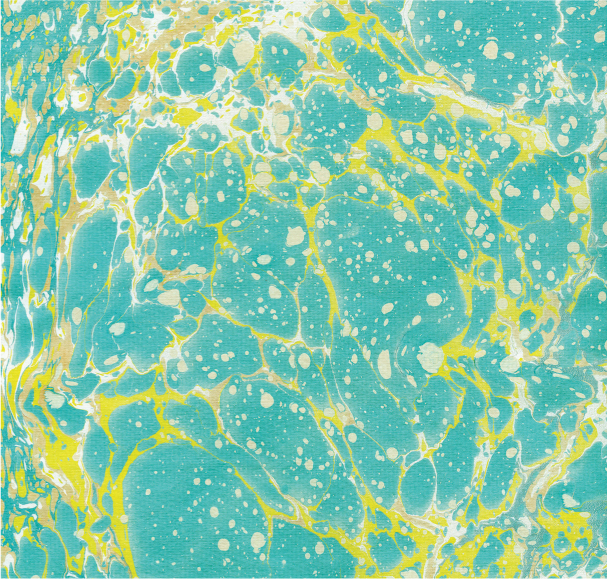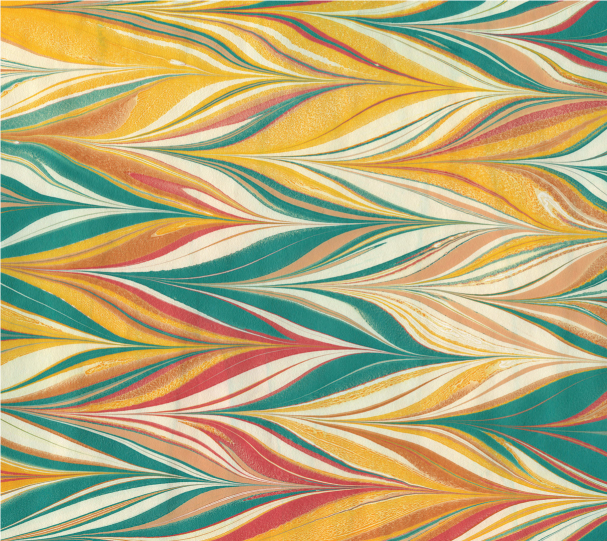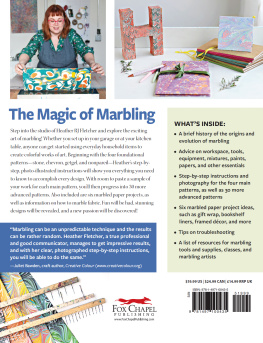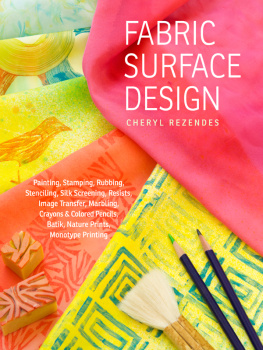Contents
Guide




2019 by HRJ Design Studio and Fox Chapel Publishing Company, Inc., 903 Square Street, Mount Joy, PA 17552.
Making Marbled Paper is an original work, first published in 2019 by Fox Chapel Publishing Company, Inc. The patterns contained herein are copyrighted by the author. Readers may make copies of these patterns for personal use. The patterns themselves, however, are not to be duplicated for resale or distribution under any circumstances. Any such copying is a violation of copyright law.
Print ISBN 978-1-4971-0043-5
eISBN: 9781607657231 For a printable PDF of the patterns used in this book, please contact Fox Chapel Publishing at , stating the ISBN and title of the book in the subject line. Library of Congress Cataloging-in-Publication Data Names: Fletcher, Heather R. J., author. Title: Making marbled paper / Heather RJ Fletcher. Description: Mount Joy : Fox Chapel Publishing, 2019. | Summary: Contains information on how to create marbled paper and silk projects based on the four basic marble patterns. | Summary: Contains information on how to create marbled paper and silk projects based on the four basic marble patterns.
Each basic marble pattern has a set of several different step-by-step techniques that include photos-Provided by the publisher-- Provided by publisher. Identifiers: LCCN 2019023955 (print) | LCCN 2019023956 (ebook) | ISBN 9781497100435 (paperback) | ISBN 9781607657231 (ebook) Subjects: LCSH: Marbling. | Marbled papers. Classification: LCC TT385 .F57 2019 (print) | LCC TT385 (ebook) | DDC 745.7/2--dc23 LC record available at https://lccn.loc.gov/2019023955 LC ebook record available at https://lccn.loc.gov/2019023956 Photography by Brooke Ringdahl Photography: All step-by-step photography, photos on the jacket, and photos on pages . Marbling tool image (pages by Llara Pazdan. Mock-up on mock-up image).
Images from Dream Big lettering). Image from mock-up image). To learn more about the other great books from Fox Chapel Publishing, or to find a retailer near you, call toll-free 800-457-9112 or visit us at www.FoxChapelPublishing.com. We are always looking for talented authors. To submit an idea, please send a brief inquiry to .  When I step into my studio, I step into a world, and mindset, of wonder and awe.Barb Skoog, marbler
When I step into my studio, I step into a world, and mindset, of wonder and awe.Barb Skoog, marbler






 CONTENTS
CONTENTS  The marbling technique suminagashi was used in the official government document backgrounds in ancient China and Japan. INTRODUCTION Making Marbled Paper is a marbling how-to book that provides you with the steps to create mesmerizing marbled patterns. A Brief History of Marbling The first marbling began in Japan in the 11th century when Zen monks used a practice called suminagashi, or floating ink, as a form of mediation and devotion. A Brief History of Marbling The first marbling began in Japan in the 11th century when Zen monks used a practice called suminagashi, or floating ink, as a form of mediation and devotion.
The marbling technique suminagashi was used in the official government document backgrounds in ancient China and Japan. INTRODUCTION Making Marbled Paper is a marbling how-to book that provides you with the steps to create mesmerizing marbled patterns. A Brief History of Marbling The first marbling began in Japan in the 11th century when Zen monks used a practice called suminagashi, or floating ink, as a form of mediation and devotion. A Brief History of Marbling The first marbling began in Japan in the 11th century when Zen monks used a practice called suminagashi, or floating ink, as a form of mediation and devotion.
Eventually, the royal houses in Japan and China used suminagashi as backgrounds for their official government documents. In the 15th century, independent financed trade opened up, allowing merchants and artisans to acquire different craft practices from different parts of the world. Marbling traveled to present-day Turkey and Iran. The craft embedded itself in Turkey. Originally employed as a decoration, marbled papers hung in the great shops of the Ottoman Empire and in the homes of wealthy. They were also given as gifts to kings.
Eventually, as done in Japan and China, these unique papers were used for official government documents. Islam had a profound effect on the craft of marbling. In Islamic public art, sentient beings and animals are forbidden because creation is Allahs prerogative. Conversely, Islam encouraged the practice of calligraphy, which was written on marbled paper. Marbling became known as ebru, or clouds on water. The Turks used Arabic gum to thicken their liquid, and locally sourced pigments for their paints.
Merchants from Europe secretly brought back these papers, wrapped with the marbled side down to avoid gift taxes. Tradesman traveled to Turkey and Persia to learn the craft of marbling. By the early 17th century, guilds were set up to create marbled papers in Europe. European marbled papers had many uses: end sheets in books, drawer liners, wallpaper, and even book covers. The Europeans used various methods to thicken their size (a thickened solution). The paints they used were locally gathered pigments mixed with ground beeswax.
When the pigment was dry, journeymen took a smooth stone and burnished the paper. The beeswax coated the paper, preserving it. Without this organic coating, the beautiful papers would have disintegrated with exposure to the climate.  Sentient beings, such as animals and people, are forbidden in Islamic art, so repeating motifs are used instead.
Sentient beings, such as animals and people, are forbidden in Islamic art, so repeating motifs are used instead.  Ebru literally means clouds on water and it was a technique popular in Turkey and Central Asia. Travelers in the 17th century collected examples of decorative marbled papers and bound them into alba amicorum (Latin for books of friendship).
Ebru literally means clouds on water and it was a technique popular in Turkey and Central Asia. Travelers in the 17th century collected examples of decorative marbled papers and bound them into alba amicorum (Latin for books of friendship).









 2019 by HRJ Design Studio and Fox Chapel Publishing Company, Inc., 903 Square Street, Mount Joy, PA 17552. Making Marbled Paper is an original work, first published in 2019 by Fox Chapel Publishing Company, Inc. The patterns contained herein are copyrighted by the author. Readers may make copies of these patterns for personal use. The patterns themselves, however, are not to be duplicated for resale or distribution under any circumstances. Any such copying is a violation of copyright law.
2019 by HRJ Design Studio and Fox Chapel Publishing Company, Inc., 903 Square Street, Mount Joy, PA 17552. Making Marbled Paper is an original work, first published in 2019 by Fox Chapel Publishing Company, Inc. The patterns contained herein are copyrighted by the author. Readers may make copies of these patterns for personal use. The patterns themselves, however, are not to be duplicated for resale or distribution under any circumstances. Any such copying is a violation of copyright law.  When I step into my studio, I step into a world, and mindset, of wonder and awe.Barb Skoog, marbler
When I step into my studio, I step into a world, and mindset, of wonder and awe.Barb Skoog, marbler






 CONTENTS
CONTENTS  The marbling technique suminagashi was used in the official government document backgrounds in ancient China and Japan. INTRODUCTION Making Marbled Paper is a marbling how-to book that provides you with the steps to create mesmerizing marbled patterns. A Brief History of Marbling The first marbling began in Japan in the 11th century when Zen monks used a practice called suminagashi, or floating ink, as a form of mediation and devotion. A Brief History of Marbling The first marbling began in Japan in the 11th century when Zen monks used a practice called suminagashi, or floating ink, as a form of mediation and devotion.
The marbling technique suminagashi was used in the official government document backgrounds in ancient China and Japan. INTRODUCTION Making Marbled Paper is a marbling how-to book that provides you with the steps to create mesmerizing marbled patterns. A Brief History of Marbling The first marbling began in Japan in the 11th century when Zen monks used a practice called suminagashi, or floating ink, as a form of mediation and devotion. A Brief History of Marbling The first marbling began in Japan in the 11th century when Zen monks used a practice called suminagashi, or floating ink, as a form of mediation and devotion. Sentient beings, such as animals and people, are forbidden in Islamic art, so repeating motifs are used instead.
Sentient beings, such as animals and people, are forbidden in Islamic art, so repeating motifs are used instead.  Ebru literally means clouds on water and it was a technique popular in Turkey and Central Asia. Travelers in the 17th century collected examples of decorative marbled papers and bound them into alba amicorum (Latin for books of friendship).
Ebru literally means clouds on water and it was a technique popular in Turkey and Central Asia. Travelers in the 17th century collected examples of decorative marbled papers and bound them into alba amicorum (Latin for books of friendship).